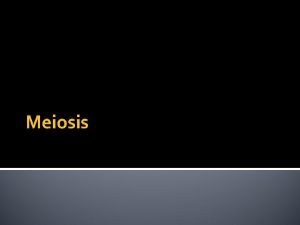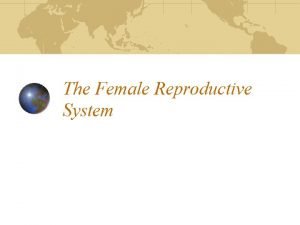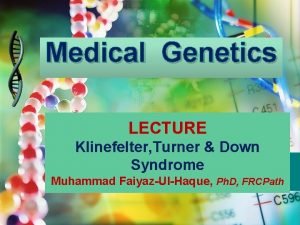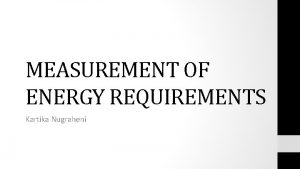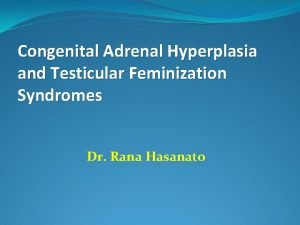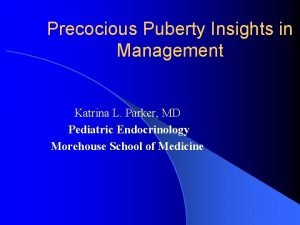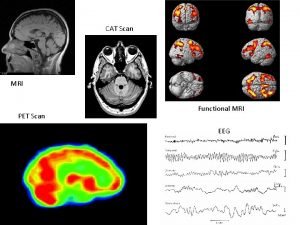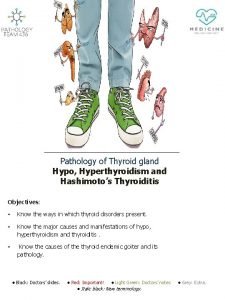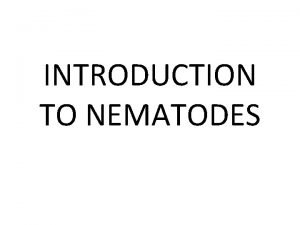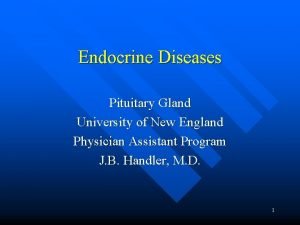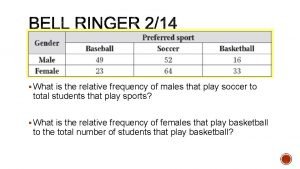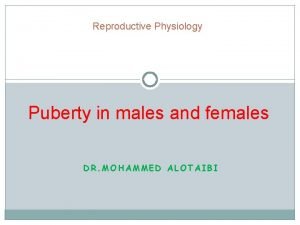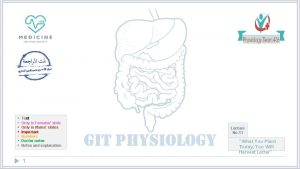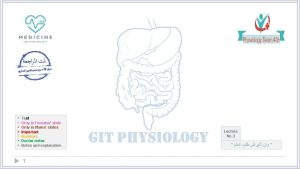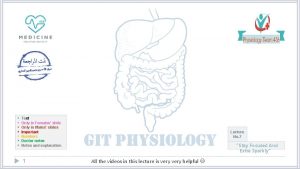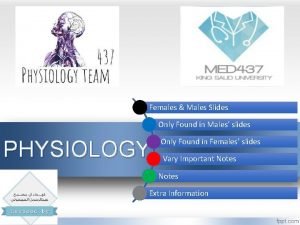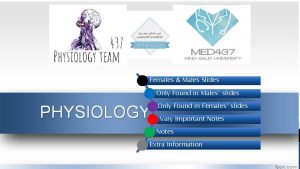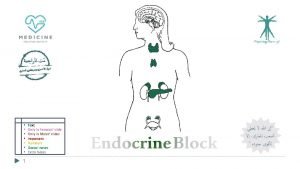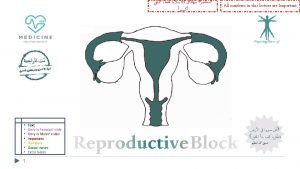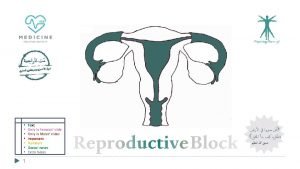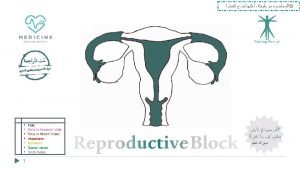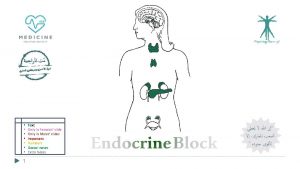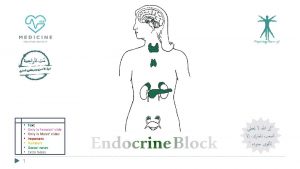Text Only in Females slide Only in Males




















- Slides: 20

§ § § § Text Only in Females’ slide Only in Males’ slides Important Numbers Doctor notes Notes and explanation 1 We recommended you to study Histology & Anatomy of pancreas first. Lecture No. 4 “Be The Best Version Of You”

Physiology of the pancreas Objectives: 1 -Functional Anatomy. 2 -Major components of pancreatic juice and their physiologic roles. 3 -Cellular mechanisms of bicarbonate secretion. 4 -Cellular mechanisms of enzyme secretion. 5 -Activation of pancreatic enzymes. 6 -Hormonal & neural regulation of pancreatic secretion. 7 -Potentiation of the secretory response. 8 - Pancreatic acini. 2

Functional Anatomy & Histology of the Pancreas Today we are concern about the digestive role of pancreas not the endocrine role, the endocrine part represent 95% of its function, the left 5% represent the digestive part. Extra Functional Anatomy: � The pancreas, which lies parallel to and beneath the stomach is a large compound gland with most of its internal structure similar to that of the salivary glands (Look like them so they have both acinar cells and tubal cells) � Islet of langerhans in the pancreas: the pancreas, in addition to its digestive functions, secretes two important hormones: Islet of Langerhans have different type of cells (alpha, beta and delta) and every single one of them can release a certain hormone. � Insulin (beta cells, 60%). � Glucagon (alpha cells, ~25%). � That are crucial for normal regulation of glucose, lipid, and protein metabolism. Also somatostatin is secreted by delta cells (form ~10% of islets’s cells). � Similar to somatostatin that secret from D cells in stomach in its function and structure, also can be secret from hypothalamus. All of them can inhibit HCl secretion. � In the stomach is considered as paracrine hormone, while in these islets is a real hormone. � The pancreatic digestive enzymes are secreted by pancreatic acini, and large volumes of sodium bicarbonate solution are secreted by the small ductules and larger ducts leading from the acini. � Pancreatic juice is secreted in response to the presence of chyme in the upper portions of the small intestine. • The acinar cells have a direct communication with the blood and capillary, to take the nutrients such as amino acid which we need them to synthesis the pancreatic enzyme which will be stored in zymogen granules, once we need them the CCK will come from I cells. To stimuli these cells to secret their enzyme down to duodenum when the sphincter of oddi is opened. • And here the ductal cells do not make kind of too much modification like in salivary gland. 3 If we go and get a cross section view of the pancreatic tissue. We can see many acinar cells and in the middle we have a ductal lumen. Between these patchy of cells we have islet of Langerhans in the center.

Histology of the Pancreas Composition of Pancreatic Juice Histology of the Pancreas Acini Islets of Langerhans Exocrine Endocrine 99% of gland 1% of gland Only in Females’ Slides Important Pancreatic proteases* Pancreatic nucleases * Sodium bicarbonat e Extra Contains pancreatic lipase* Water Pancreatic amylase* 4 * Digestive enzymes.

Only in Females’ Slides Important Secretory function of pancreas � Acinar and ductal cells in the exocrine pancreas form a close functional unit. � Pancreatic acini secrete the pancreatic digestive enzymes through zymogens. � The ductal cells secrete large volumes of sodium bicarbonate solution (In charge of exchange of bicarb with chlorid). � The combined product of enzymes and sodium bicarbonate solution then flows through a long pancreatic duct. � Pancreatic duct joins the common hepatic duct to form hepatopancreatic ampulla. � The ampulla empties its content through papilla of vater which is surrounded by sphincter of oddi The r. ER is at the basolateral membrane so it can be close to the blood to take the aminoacids to form proteins. Stored and goes to Golgi for modification > vacuoles reaches area close to lumen as zymogen granule, here any stimuli will make it fuse with the apical membrane and release the enzymes. � Pancreatic enzymes originate in the acinar cells. � Secretion of water and electrolytes originates in the centroacinar and intercalated duct cells. � Final product is a colorless, odorless, and isosmotic alkaline fluid that contains digestive duct > meets with the common bile duct > ampulla of vater through Acinar cells > intercalated ducts > interlobular duct > main pancreatic enzymes (amylase, lipase, chymotrypsinogen and trypsinogen). 5 the major papilla (surrounded by sphincter of oddi) > duodenum. The common bile duct is made of the common hepatic duct and the cystic duct of gallbladder.

Important Pancreatic Secretion The major functions of pancreatic secretion: � The main function To neutralize the acids in the duodenal chyme to optimum range (ph= 7. 0 -8. 0) (ph=7. 6 -9. 0) for activity of pancreatic enzymes. � To prevent damage to duodenal mucosa by acid & pepsin (Only this enzyme need acidic medium to be activated, the other enzyme need alkaline solution). � � � The chyme is very acidic, so it needs to be neutralized by a basic fluid (up to 9 PH) so it doesn’t anycan damage. Both liver and cause duodenum secret HCO 3, but the main source of To produce enzymes involved in the digestion of dietary carbohydrate, fat, and protein. HCO 3 is the Pancreas. So if it stop we will have decrease in PH and may develop the duodenum ulceration. Only in Males’ Slides � Pancreatic secretions contain many enzymes for digesting proteins, carbohydrates(starch), and fats(Lipids), and large quantities of HCO 3 ions. The most important pancreatic enzymes for digesting proteins are: Trypsin Chymotrypsin split whole and partially digested proteins into peptides of various sizes but do not cause release of individual amino acids. Carboxypolypeptidase splits some peptides into individual amino acids, thus completing digestion of some proteins to amino acids. When first synthesized in the pancreatic cells, the proteolytic digestive enzymes are in the inactive forms Inactive form Trypsinogen Chymotrypsinogen Procarboxypolypeptidase These enzymes become activated only after they are secreted into the intestinal tract. Activated by 1. 2. Enteropeptidase (enterokinase), an enzyme secreted by the intestinal mucosa when chyme comes in contact with the mucosa. Trypsinogen can be autocatalytically activated by trypsin formed from previously secreted trypsinogen. Trypsin to form chymotrypsin and carboxypolypeptidase. • Acually we do not need to digest the protein to individual amino acids completly in the luemen, because the entrocyte(epitheilum cells which are lining the mucosa of small intestine), they can absorp di-tri peptide in addition to individual amino acids. All of them have their own transporter to take them from the lumen to entrocyte, And inside these cells they will broken down into amino acids before enter the blood circulation by enteropeptidase. • Sometimes it could also as brush border enzymes. But we have to specify them as Enteropeptidase or enterokinase and both are the same. • Now all pancreatic enzymes are activated in the duodenum of the small intestine by trypsin which activated by Enteropeptidase or enterokinase. 6

Cont. � � � Secretion of trypsin inhibitor prevents digestion of the pancreas itself. Proteolytic enzymes of the pancreatic juice do not become activated until after they have been secreted into the intestine because the trypsin and the other enzymes would digest the pancreas itself. The same cells that secrete proteolytic enzymes into the acini of the pancreas secrete another substance called trypsin inhibitor, which is formed in the cytoplasm of the glandular cells, and it prevents activation of trypsin both inside the secretory cells and in the acini and ducts of the pancreas. � Because trypsin activates the other pancreatic proteolytic enzymes, therefore trypsin inhibitor prevents activation of the other enzymes as well. � The trypsin inhibitor will be degeaded once it is secreted out from the pancrease into intestin. The alpha amylase which is secreted from pancrease is more potent than the lingual one. 7 What protect pancreas from digestion by its enzymes? Only in Females’ Slides � Pancreatic enzymes are secreted in inactive form: trypsinogen, chymotrypsinogen, procarboxypolypeptidase. � They will be activated by enterokinase enzyme in small intestine to their active forms. � The acinar cells that secrete the enzymes secretes trypsin inhibitor which prevent activation of trypsin inside acini and ducts. � When a duct is blocked the trypsin inhibitor can not inhibit activation of accumulated enzymes which will be activated and digest the pancreas in few hours. � Enterokinase is an enzyme that is secreted by brush border of small intestine and activate pancreatic enzymes. � Trypsin inhibitor is secreted by acinar cells to prevent activation of the enzymes inside the cells, in the acini and in the ducts. � In the stomach, HCL is what activates the enzymes. � Here, we have trypsin inhibitors and enterokinase to control the activation. � Because as soon as trypsin is activated, this will lead to activation of all other enzymes.

Cont. � • Pancreatic amylase is much powerful than alpha amylase. • That’s why, the digestion of carbohydrates do not last to much, you can digest all carbohydrates you ate within 20 -30 minutes in duodenum. • That’s why, the diabetic patient when they eat any carbohydrates, their blood glucose or sugar is raised rapidly, because they digested and absorbed rapidly and we do not need that sophisticated atmosphere to digest them to monosaccharides not to disaccharides. Activation of Trypsinogen in duodenal Lumen: • If you want to absorb carbohydrate U MUST change is into monosaccharides form memories the composition of disaccharides. • Lipids are digested in the stomach NOT in the mouth. • carbs start digestion in mouth. Only in Males’ Slides � The pancreatic enzyme for digesting carbohydrates is pancreatic amylase, which hydrolyzes starches, glycogen, and most other carbohydrates(except cellulose) to form mostly disaccharides and a few tri-saccharides. � Most of our digested carbohydrates that we are getting from our food are in form of disaccharides not starch, so we do not need alpha amylase to broken down to disaccharides and then we need brush border enzyme in enterocytes to digest them to monosaccharides which then will be absorbed by certain transports Carbohydrates digestion If we eat the carbohydrates in these form of disaccharides, they only need brush border enzyme to be digested which can be released from epithelium cells of luminal wall of duodenum. 8

Only in Males’ Slides Important Cont. � The main enzymes for fat digestion are: 1. Pancreatic lipase (Also we have lingual lipase can digest 10% in stomach) 1. Cholesterol esterase. 2. Phospholipase (A 2). � The suffix –ogen or prefix pro- indicates the enzyme is secreted in an inactive form. Specific hydrolytic activity Nucleolytic Ribonuclease 9 Deoxyribonucle ase Amylolytic -Amylase Lipases Lipase Prophospholipa se A 2 Carboxylester hydrolase (cholesterol esterase) Proteolytic Endopeptid ases Trypsin(og en) Chymotryp sin(ogen) (Pro)elasta se Exopeptida se (Pro)carbo xypeptidas e

Pancreatic secretions are rich in bicarbonate ions Only in Males’ Slides ﻣﻬﻢ ، ﻫﺬﻩ ﺍﻟﺮﺳﻤﺔ ﻣﺘﻜﺮﺭﺓ ﻓﻲ ﺃﻜﺜﺮ ﻣﻦ ﻣﺤﺎﺿﺮﺓ ! ﺗﻌﺮﻓﻮﻫﺎ � The pancreas secrets about 1 L/day of HCO 3 –rich fluid from the epithelial cells of the ductules and ducts. � The osmolarity of pancreatic fluid is equal to that of plasma. � HCO 3 concentration increases with increasing secretion rate. • One of The main difference with saliva is that here the cell is preamble to water so we have isotonic solution while in saliva it was impermeable to water that’s why we have hypotonic solutions. • Secretin stimulates it this protein exchanger. • Cl / bicarbonate exchanger. • Once we get the Hco 3 from Carbonic anhydrase reaction , the exchange occur to secrete Hco 3 into lumen. • 2 - we also can get Hco 3 by Na – Hco 3 co-transport into the cell that will be exchanged by cl to go to the lumen. • Differnces between here and the salivon: 1 - the secretion isotonic while in salivon hypotonic , due to the water permeability of the cells. 2 - the blood will be more acidic due to increase H+ secretion into blood. • We have seen the same pictures when we took the saliva, except in the luminal membrane which is toward the lumen we have other transporter such as Cl/ HCO 3 exchanger if I increase its rate I will increase the secretion of HCO 3 toward the lumen such as by certain hormones (secretin). • In contrast with saliva, the high speed of secretion, the more HCO 3 I will get. So the speed of secretion does not affect the concentration. • In Contrast with what we have in stomach , the H ions reabsorbed to blood which increase its acidity. • by exchange Na with HCO 3, we have other source of HCO 3 other than CA reaction. • by co-transporter Na with HCO 3 , we have other 10

Only in Females’ Slides Mechanism of HCO 3 - Secretion � Apical membrane of ductal cells contains a Cl-/HCO 3 exchanger. � � Basolateral membrane contains Na+/K+ ATPase and a Na+/H+ exchanger (to transport bicarb into the duct). ﺑﺲ ﺍﻧﺘﺒﻬﻮﺍ ، ) ﻫﺬﻩ ﺍﻟﺼﻮﺭﻩ ﻣﺸﺮﻭﺣﺔ ﺑﺎﻟﺘﻴﻢ ﺑﺎﻟﺘﻔﺼﻴﻞ ﻓﻲ ﺍﻟﻤﺤﺎﺿﺮﺓ ﺍﻟﺜﺎﻧﻴﺔ ( ﻣﻌﻜﻮﺳﺔ ﺍﻹﺗﺠﺎﻫﺎﺕ � CO 2 and H 2 O combine in ductal cells by carbonic anhydrase to form H+ and HCO 3 -. � HCO 3 - is secreted into pancreatic juice by Cl-/HCO 3 exchanger. � H+ is transported into blood by Na+/H+ exchanger. � Absorption of H+ causes acidification of pancreatic venous blood. 11 Secretion of Isosmotic Sodium Bicarbonate Solution.

Pancreatic secretion is under neural and hormonal control Only in Males’ Slides Only in Females’ Slides � � � Parasympathetic stimulation (through ach on acinar cells) results in an increase in enzyme secretion-fluid and HCO 3. Secretin tends to stimulate a hco 3 rich secretion by activating ductal cells. Cck stimulates a marked increase in enzyme secretion by stimulating the acinar cells. Pancreatic secretion normally results from the combined effects of the multiple basic stimuli, not from one alone (potentiate each other). It means that pancreatic secretion will be produced due to the stimuli from (CCK, secretin, ach) they stimuli TOGETHER AT THE SAME TIME, to potentiate and to increase the amount of the secretion , so the amount of pancreatic secretion will be much higher if these hormones will stimuli at the same time rather than each one individual. All of these work together to release too much HCO 3 secretion. 12 � Control of pancreatic secretion: 1. Acinar cells (enzymatic secretion) o Receptors for CCK and muscarinic receptors for ACh o CCK is most important stimulant. (i cells) secrete CCK in presence of amino acids and fatty acids in intestinal lumen. o ACh also stimulates enzyme secretion. 2. Ductal cells (aqueous secretion of HCO 3 -) o Receptors for CCK, ACh, and secretin. o Secretin (from S cells of duodenum) is major stimulant Secreted in response to H+ in intestine. o Effects of secretin are potentiated by both CCK and ACh. o Secretin travels to blood to pancreatic ducts to release Bicarb and water.

Only in Males’ Slides Stimuli for pancreatic secretion Acetylcholine Released from the parasympathetic vagus nerve endings and from other cholinergic nerves in the enteric nervous system. Cholecystokinin Secreted by the duodenal and upper jejunal mucosa (i cells) when food enters the small intestine. Stimulate the acinar cells of the pancreas, causing production of large quantities of pancreatic digestive enzymes, but relatively small quantities of water and electrolytes to go with the enzymes. Secretin Also secreted by the duodenal and jejunal mucosa (s cells) when highly acidic chyme enters the small intestine. • • • 13 In contrast to the first two basic stimuli, stimulates secretion of large quantities of h 2 o and nahco 3 solution by the pancreatic ductal epithelium. Secretin stimulates secretion of copious quantities of bicarbonate ions—neutralization of acidic stomach chyme. Secretin is present in an inactive form, prosecretin (in s cells in the mucosa of the duodenum and jejunum). When acid chyme with ph less than 4. 5 -5. 0 enters the duodenum from the stomach, it causes duodenal mucosal release and activation of secretin, which is then absorbed into the blood. Secretin causes the pancreas to secrete large quantities of fluid containing a high concentration of hco 3 (up to 145 meq/l = ~5 x normal) but a low concentration of cl-. HCl + Na. Hco 3 → Nacl + H 2 co 3 H 2 CO 3 dissociates into CO 2 and H 2 O

Only in Males’ Slides Cont. � Cholecystokinin Its Contribution to Control of Digestive Enzyme Secretion by the Pancreas. � The presence of food in the upper small intestine causes cholecystokinin to be released from the I cells in the mucosa of the duodenum and upper jejunum. � Release of cholecystokinin results especially from the presence of proteoses and peptones (products of partial protein digestion) and long-chain fatty acids in the chyme. � Cholecystokinin, like secretin, passes by way of the blood to the pancreas and causes secretion of pancreatic digestive enzymes by the acinar cells. � This effect is similar to that caused by vagal stimulation but even more pronounced, accounting for 70 -80% of the total secretion of the pancreatic digestive enzymes after a meal. Remember : each hormones as its own role in secretion , CCK mainly enzymes , while secretin mainly Hco 3. 14

Only in Males’ Slides Multiplicative or potentiation effects of different pancreatic secretion stimuli � � ﻣﺸﺮﻭﺣﺔ ﺑﺸﻜﻞ ﺗﻔﺼﻴﻠﻲ ﻓﻲ ﺍﻟﻤﺤﺎﺿﺮﺓ phases ﺍﻝ ﺍﻟﺜﺎﻟﺜﺔ When all different stimuli of pancreatic secretion (acetylcholine, cholecystokinin, and secretin) occur at once, then the total secretion is far greater than the sum of the secretions caused by each stimulus separately. The stimuli are said to “multiply” or “potentiate” one another. Usually, pancreatic secretions are the result of multiple stimuli rather than one stimulus. Pancreatic secretion is phasic Phase stimulus Mediators Cephalic phase Smell, taste, chewing and swallowing Release of Ach Gastric phase In general • • From CNS Through vagus nerve. 20% of pancreatic enzymes. • The stomach is distended, so it will send impulses to the brain to prepare the pancreas to release some of its content. Through vagus nerve 5 -10% of pancreatic enzymes Protein, gastric distention Vago-vagal reflex • • Intestinal phase The most important one 15 • • Acid in chyme, fatty acids Secretin, CCK and vago-vagal reflex • For digestion and protection. Through hormonal stimulation (secretin & CCK). 70 -75% of pancreatic enzymes & fluid.

Only in Females’ Slides Cont. If stones block the ampulla or papilla of vater, the enzymes will be pushed back to the pancreas and they will reach a point where they can’t be inhibited anymore, so they will digest the pancreas it self. 16

Only in Females’ Slides Cont. Here we have pancreatic secretion full of these enzymes > 17

Hormonal Control of Gastrointestinal Motility (GI Peptides) Hormone Gastrin Site of secretion ﻟﻜﻨﻪ ﻣﺘﻜﺮﺭ ﻋﻨﺪ ﺍﻷﻮﻻ ﺩ ﻓﻲ ، ﻫﺬﺍ ﺍﻟﺠﺪﻭﻝ ﻣﻮﺟﻮﺩ ﻓﻲ ﻫﺬﻩ ﺍﻟﻤﺤﺎﺿﺮﺓ ﻋﻦ ﺍﻟﺒﻨﺎﺕ ﻓﻘﻂ ﺍﺣﻔﻈﻮﺍ ﺍﻟﺠﺪﻭﻝ ﺯﻱ ﻣﺤﺎﺿﺮﺍﺕ ﺃﺨﺮﻯ Stimuli for secretion G cells of the antrum, • duodenum and • jejunum. • • Only in Males’ Slidesc ﺍﺳﻤﻜﻢ Actions Protein Stimulates: gastric H+ secretion Distention of the and growth of gastric mucosa. stomach Vagal stimulation (GRP) Acid inhibits release I cells of the Cholecystokinin (CCK) duodenum, jejunum, and ileum. • • • Protein Fatty acids Acids Stimulates: pancreatic enzyme secretion, pancreatic HCO 3 secretion, gallbladder contraction, growth of the exocrine pancreas, and relaxation of the sphincter of oddi. Inhibits: gastric emptying. S cells of the duodenum, jejunum, and ileum • Acids and fat in the duodenum. Stimulates: pepsin secretion, pancreatic HCO 3 - secretion, biliary HCO 3 - secretion, and growth of the exocrine pancreas. Inhibits: gastric H+ secretion. • • • Protein Fatty acids Oral glucose Stimulates: insulin secretion from pancreatic β cells. Inhibits: gastric H+ secretion. Fat Acid Nerve Stimulates: • Gastric motility • Intestinal motility Secretin Glucose-dependent K cells of the insulinotropic peptide duodenum and (GIP) jejunum. Motilin 18 M cells of the duodenum and jejunum

Only in Females’ Slides Activation of enzymes precursors in the small intestine Important Activation of enzymes precursors in the small intestine 19 precursor Via Active enzyme Trypsinogen Enterokinase, Trypsin + peptide Chymotrypsinogen Trypsin Chymotrypsin + peptide Proelastase Trypsin Elastase + peptide Procarboxypeptidase Trypsin Carboxypeptidase + peptide Prophospholipase A Trypsin Prophospholipase A + peptide

Thank you!. ﺍﻋﻤﻞ ﻭ ﺃﻨﺖ ﺗﻌﻠﻢ ﺃﻦ ﺍﻟﻠﻪ ﻻ ﻳﻀﻴﻊ ﺃﺠﺮ ﻣﻦ ﺃﺤﺴﻦ ﻋﻤﻼ ، ﺍﻋﻤﻞ ﻟﺘﻤﺴﺢ ﺩﻣﻌﺔ ، ﺍﻋﻤﻞ ﻟﺘﺮﺳﻢ ﺑﺴﻤﺔ The Physiology 436 Team: Team Leaders: Females Members: Laila Mathkour Mohammad Alayed Anwar Alajmi Fouad Bahgat Deena Alnowaiser Amal Alshaibi Rawan Alqahtani References: • • • 2017 -2018 Dr. Hana Alzamel’s Lecture. Rana Barasian 2017 -2018 Dr. Mohammed Al Zoghaibi’s Lecture. Guyton and Hall Textbook of Medical Physiology (Thirteenth Edition. ) 20 . ﻓﺮﺩﻩ ﻟﻲ ﻭﻗﺖ ﺣﺎﺟﺘﻲ ﺇﻟﻴﻪ ﻳﺎ ﻣﻦ ﻻ ﺗﻀﻴﻊ ﻋﻨﺪﻩ ﺍﻟﻮﺩﺍﺋﻊ ، ﺍﻟﻠﻬﻢ ﺍﻧﻲ ﺍﺳﺘﻮﺩﻋﺘﻚ ﻣﺎ ﺣﻔﻈﺖ ﻭﻣﺎ ﻗﺮﺃﺖ ﻭﻣﺎ ﻓﻬﻤﺖ Contact us:
 Meioss
Meioss The unequal access of males and females to property
The unequal access of males and females to property Making connections images
Making connections images What is heel and toe polka
What is heel and toe polka Generations in a pedigree
Generations in a pedigree How many immature eggs are females born with
How many immature eggs are females born with Klinefelter's disease
Klinefelter's disease Rumus bee
Rumus bee 3 inappropriate dress items for fbla
3 inappropriate dress items for fbla Feminization tubes
Feminization tubes Tanner staging
Tanner staging L
L Nageeb thought all nurses
Nageeb thought all nurses Thyroid issues in women
Thyroid issues in women Characteristics of helminths
Characteristics of helminths In 1971 there were 294 105 females
In 1971 there were 294 105 females Gigantism vs acromegaly
Gigantism vs acromegaly Ffa dresscode
Ffa dresscode What is the relative frequency for males ?
What is the relative frequency for males ? Fritz haarmann childhood
Fritz haarmann childhood Puberty
Puberty
